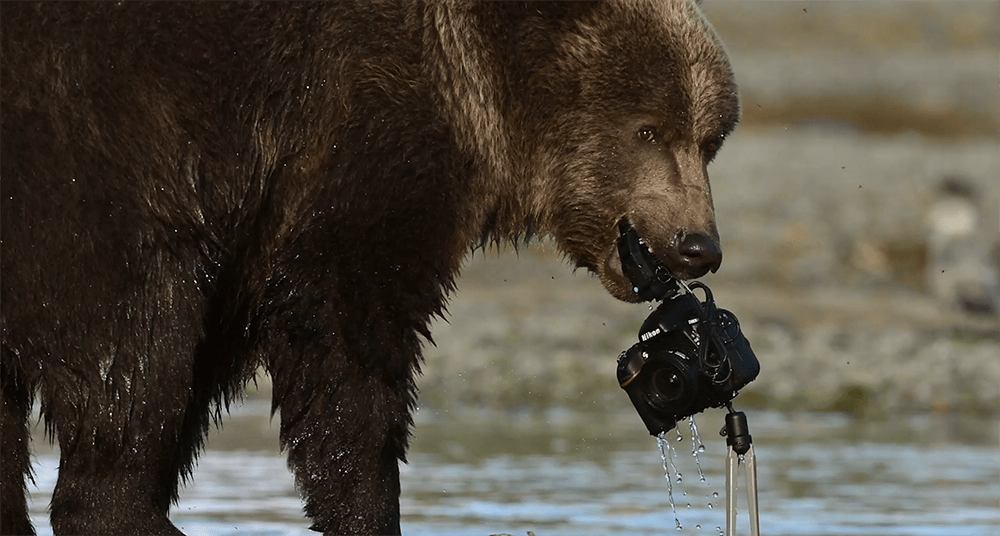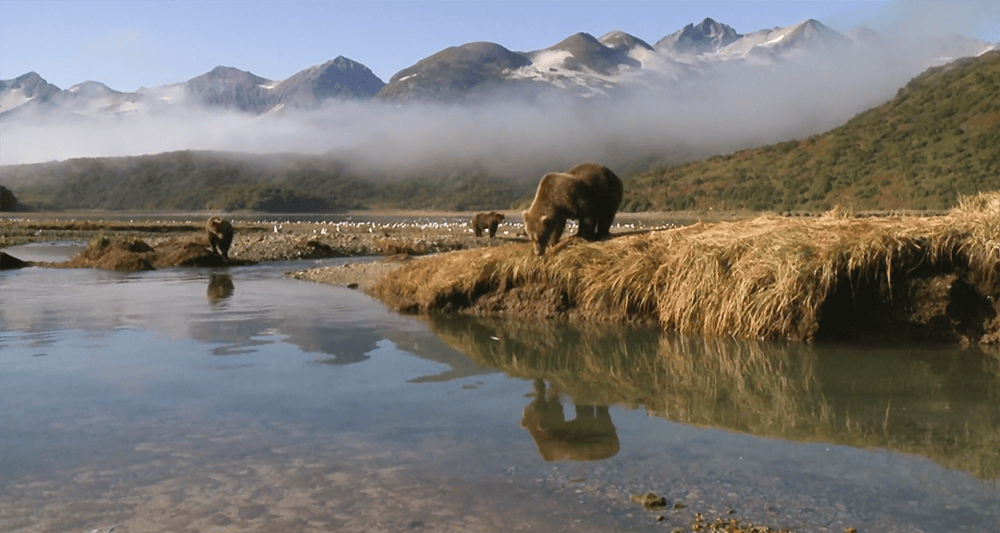As the sun drops behind the mountain range, bear researcher David Bittner strolls along the rugged shoreline of Alaska’s wilderness to a grizzly’s food cache (food hidden by a bear). All around, the sand is raked with massive claw marks all leading to a mound. Bittner digs away some of the sand, revealing a bear’s paw, the size of a dinner plate. He examines the struggle in similar fashion to police investigating a crime scene. Looking concerned, he hastily makes his departure. Knowing the danger bears can present to one another, director Roman Droux ominously narrates, “Hopefully it is not Luna or Balu which was killed and is now buried in the sand as food cache.”
This concerning turn of events contrasts to the joyous film opening featuring Bittner sitting next to the bear, Luna, who shows a level of contentment similar to a domesticated German shepherd. Such contrasts between beauty, attachment, struggle for survival, and the harsh natural unbiased Alaskan wilderness power the movie Bear Like, directed by Roman Droux.
Throughout the film, we feel Bittner’s attachment to these two bears, Luna and Balu. He will continue to search for them as the story unfolds, reflecting a deep concern for their well-being on par with feelings of connection one has for a close friend.
Stunning panoramic views of the Alaskan landscape, majestic fully grown bears and fuzzy bear cubs, along with cold dispassionately harsh moments, remind the viewer that nature is not a Disney movie. Bear Like covers the balance of life's ups and downs in pure wilderness, with bears as the focus and man (Droux and Bittner) as the observer.
Throughout the film, the two men are gut wrenchingly close and intimate with the titanic animals. The bears, though, are for the most part indifferent. In the opening scenes, Bittner affectionately teases Luna for trying to make it past the electrical wire around his campsite, and bids her a good night from inside his tent.
Additional characters include a bear family. Despite being so close, the camera equipment becomes the greatest casualty—a GoPro is an unintended sacrifice for a glorious close up of the mother bears canines. Roman Droux says matter-of-factly. “Luckily only the camera. Mother bears are famously determined to defend their cubs.”
BEAR LIKE Cinematography is Hypnotic
We take in sights of bears foraging on the Katmai Peninsula like “cows on the alps.” It is easy to be hypnotized by the cinematography. We see close-up shots of bears from cameras peering right up from the grass. Later, the camera zooms in on a bear submerged in water from a vantage so close it will likely make your palms sweat. Golden damp afternoon light or the cool crisp light at dawn, often shrouding the bear’s feeding grounds and the men’s campsite, makes the viewer feel like they are right alongside Droux and Bittner. This is complemented by the narration of Droux who shadows Bittner as he takes us deep into Bear Country.
However beautiful the scenery, this unspoiled haven for wildlife is equally unforgiving. The ruthlessness of the Bears towards even the smallest, most vulnerable amongst them, casts a dark shadow over the glamour of unspoiled wilderness. “I know it’s not right to interfere with the natural course of things here.” Droux remarks, “Far away from everything but still right in the middle of things: life and death seem extremely intertwined.”
While man’s role is meant to be as an unbiased observer throughout the film, and a guest in the wild, the relationship between the two men and their surroundings is clear. “Thousands of men like me wouldn’t be good, for this land and these animals, as a human in this territory you will always be a disturbing factor.”
One might easily forget they are observing wild animals based on Bittner’s casual demeanor. After a bear charges Bittner, who does not budge from where he is sitting, Droux states, “There are people who say it’s only a matter of time before you too are eaten by a bear.” Bittner casually explains, “Yes, that risk exists… I don’t listen to those people,” He continues, “I listen to people who know me, who know that my approach to these animals isn’t careless or light-headed but is respectful instead.”
This film captures both the beauty and hardships of the wild, in this writer’s view. Droux’s up-close views of wild bears goes far beyond the romantic perception of wildlife common to many living in cities. We are exposed to the grim lengths bears and other wildlife will go to in order to survive. For those looking for a light-hearted film about animals this is not for you. For those fascinated by nature, looking for an in-depth view into untamed wilderness, and the extremes of human experiences, this film is for you.
HIGHLY RECOMMENDED
Nominate this for The Picture This Post BEST OF 2020???
Click Readers' Choice
Vote Securely! Vote Privately! And Make Your Vote Count-- as all voting should be!!
Visit BEAR-LIKE- Films for the Earth for more information.
Editor’s Note: BEAR LIKE was originally reviewed as part of the Picture This Post Coverage of the Greenpoint Film Festival.

About the Author: Max Harris-D’Amato
Max Harris-D’Amato is a freelance writer, who graduated from Columbia College Chicago in the spring of 2019 with a B.A. in multimedia journalism. In addition to both short and long form writing he has also directed a documentary, Surfing the Rust Belt, which he personally pitched, shot video, edited and conducted interviews for. In addition to writing, he has served with AmeriCorps on the Pacific Crest Trail and teaches English as a foreign language. He is passionate about traveling, current events and conservation.
Watch Max D’Amato’s film SURFING THE RUST BELT here.







Nominated for Picture This Post BEST OF 2020
Nominated for Picture This Post BEST OF 2022